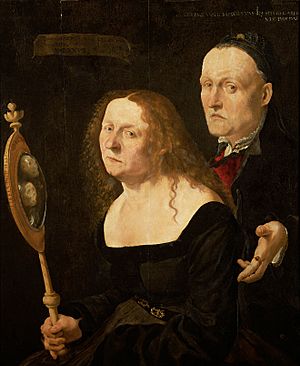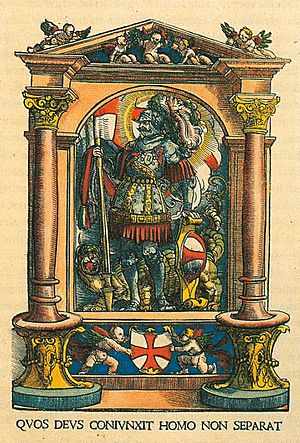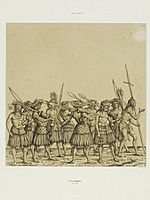Hans Burgkmair facts for kids
Quick facts for kids
Hans Burgkmair
|
|
|---|---|

The painter Hans Burgkmair and his wife Anna (painting by Lukas Furtenagel, 1529)
|
|
| Born | 1473 Augsburg, Germany
|
| Died | 1531 (aged 57–58) Augsburg, Germany
|
| Nationality | German |
| Known for | Painting, printmaking, woodcut |
Hans Burgkmair the Elder (born in 1473, died in 1531) was a famous German painter and woodcut printmaker. He was known for his amazing artworks, especially his woodcuts, which are like early prints made from carved wood.
Contents
Early Life and Training
Hans Burgkmair was born in Augsburg, a city in Germany. His father, Thomas Burgkmair, was also a painter. Later, Hans's own son, Hans the Younger, followed in their footsteps and became a painter too!
When Hans Burgkmair was about 15 years old, in 1488, he started learning from a famous artist named Martin Schongauer in Colmar. Schongauer sadly passed away in 1491, before Hans could finish his training.
Around this time, Hans might have traveled to Italy. He definitely visited Italy in 1507, and this trip greatly changed his art style. From 1491, he worked in Augsburg. By 1498, he became a "master" artist, meaning he was skilled enough to open his own art workshop. Hans Burgkmair was also a follower of the Lutheran faith.
His Artistic Career

Hans Burgkmair created a huge number of woodcuts, which are prints made by carving an image into a block of wood, then inking it and pressing it onto paper. Art experts believe he made 834 woodcuts! Most of these were used to illustrate books. A smaller number, just over a hundred, were "single-leaf" prints, meaning they were individual artworks not meant for books.
His art style was special because it mixed the new ideas from the Italian Renaissance with the traditional German art style. This made his pictures very striking and interesting.
Working for the Emperor
From about 1508, Hans Burgkmair spent a lot of his time working on big woodcut projects for Emperor Maximilian I. He continued this work until the Emperor died in 1519.
Burgkmair was responsible for almost half of the 135 prints in a famous series called Triumphs of Maximilian. These prints were large and showed many detailed characters. He also created most of the pictures for two other important books, Weiss Kunig and Theurdank. He often worked closely with a skilled blockcutter named Jost de Negker, who helped publish his prints.
Innovations in Printmaking
Burgkmair was a very important artist who helped develop a new type of woodcut called the chiaroscuro woodcut. This technique used different shades of color to create a more painterly effect. He seems to have been the first artist to use a "tone block" in a print, which he did in 1508.
His print called Lovers Surprised by Death (made in 1510) was the first chiaroscuro print to use three separate blocks of wood to create different colors. It was also designed to be printed only in color, as the outline by itself wouldn't look complete. Other artists like Baldung and Cranach also made chiaroscuro prints around this time, but their outline blocks could be printed on their own.
Even though he trained with a famous engraver, Burgkmair only made one etching (a type of print made by drawing on a metal plate with acid). This etching, called Venus and Mercury, was made around 1520 on a steel plate. He never tried engraving (another printmaking method) himself.
Paintings and Legacy
Besides his amazing prints, Burgkmair was also a very successful painter. He mainly painted religious scenes, portraits of people from Augsburg, and members of the Emperor's court. You can see many of his paintings in art galleries in Munich, Vienna, and other cities.
Hans Burgkmair passed away in Augsburg in 1531. His work helped shape art during the German Renaissance.
Depicting Different Cultures
Hans Burgkmair lived during a time when people were very interested in learning about different cultures and places. This was part of a new way of studying the world called chorography, which was promoted at the University of Vienna.
A scholar named Konrad Peutinger encouraged Emperor Maximilian to support studies about people from India. This led to a voyage by Balthasar Springer around Africa to India in 1505–1506.
Based on what the Emperor wanted, other artists made drawings and miniatures showing "the people of Calicut" (a place in India). Hans Burgkmair then used some of these ideas to create woodcuts for the Triumphal Procession series.
In 1508, Burgkmair also created a series called People of Africa and India. These prints showed the people Springer met along the coasts of Africa and India. This series was very important because it helped create a basic way of studying and describing different groups of people, which is now part of a field called ethnography.
Gallery
See also
 In Spanish: Hans Burgkmair para niños
In Spanish: Hans Burgkmair para niños
- German Renaissance
- Quaternion Eagle








